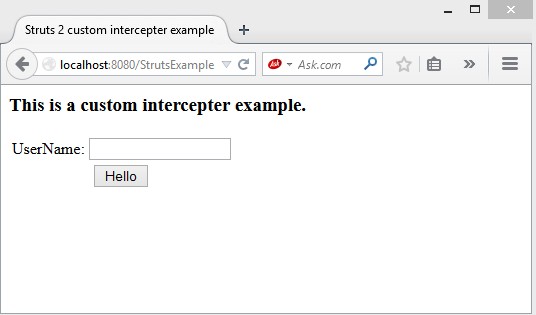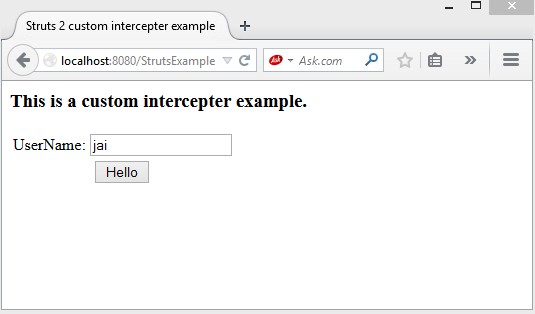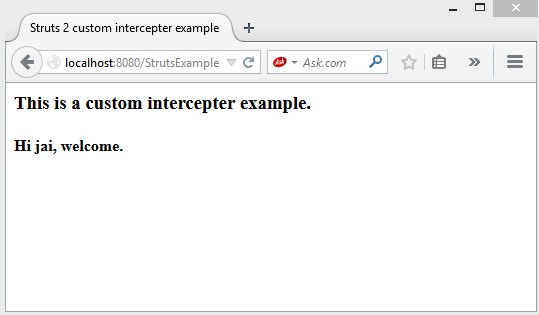We can create a custom interceptor in struts 2. To create a custom interceptor implements the Interceptor interface. Interceptor interface provides the methods to create a custom interceptor.
Methods of Interceptor interface:
1. init(): It is used to initialize the interceptor. It is called only once by the web container.
public void init()
2. intercept(ActionInvocation invocation): It is used to define the processing logic of the interceptor.
Syntax: public void intercept(ActionInvocation invocation) throws Exception
3. destroy(): It is used for clean-up process before destroying the interceptor.
public void destroy()
Struts 2 custom interceptor example:
login.jsp
<%@ taglib uri="/struts-tags" prefix="s"%> <html> <head> <title>Struts 2 custom interceptor example</title> </head> <body> <h3>This is a custom interceptor example.</h3> <s:form action="Login"> <s:textfield name="userName" label="UserName" /> <s:submit value="Hello" align="center"/> </s:form> </body> </html> |
web.xml
<?xml version="1.0" encoding="UTF-8"?> <web-app version="2.5" xmlns="http://java.sun.com/xml/ns/javaee" xmlns:xsi="http://www.w3.org/2001/XMLSchema-instance" xsi:schemaLocation="http://java.sun.com/xml/ns/javaee http://java.sun.com/xml/ns/javaee/web-app_2_5.xsd"> <filter> <filter-name>struts2</filter-name> <filter-class> org.apache.struts2.dispatcher.ng. filter.StrutsPrepareAndExecuteFilter </filter-class> </filter> <filter-mapping> <filter-name>struts2</filter-name> <url-pattern>/*</url-pattern> </filter-mapping> <welcome-file-list> <welcome-file>login.jsp</welcome-file> </welcome-file-list> </web-app> |
struts.xml
<!DOCTYPE struts PUBLIC "-//Apache Software Foundation//DTD Struts Configuration 2.0//EN" "http://struts.apache.org/dtds/struts-2.0.dtd"> <struts> <package name="user" extends="struts-default"> <interceptors> <interceptor name="welcomeIntercepter" class="com.w3schools. customintercepter.CustomIntercepter"> </interceptor> </interceptors> <action name="Login" class="com.w3schools.action.Login"> <interceptor-ref name="defaultStack"/> <interceptor-ref name="welcomeIntercepter"/> <result name="success">/welcome.jsp</result> </action> </package> </struts> |
Login.java
/** * This class is used as an action class. * @author w3schools */ public class Login { //data members private String userName; //business logic public String execute(){ System.out.println("Login's execute() " + "is called..."); return "success"; } //getter setters public String getUserName() { return userName; } public void setUserName(String userName) { this.userName = userName; } } |
CustomIntercepter.java
import com.opensymphony.xwork2.ActionInvocation; import com.opensymphony.xwork2.interceptor.Interceptor; import com.opensymphony.xwork2.util.ValueStack; /** * This class is used for custom intercepter. * @author w3schools */ public class CustomIntercepter implements Interceptor{ public void init() { System.out.println("CustomIntercepter's " + "init methods is called."); } public String intercept(ActionInvocation actionInvocation) throws Exception { System.out.println("Before " + "actionInvocation.invoke() called."); ValueStack stack = actionInvocation.getStack(); String userName = stack.findString("userName"); stack.set("userName","Hi " + userName + ", welcome."); String resultString = actionInvocation.invoke(); System.out.println("After " + "actionInvocation.invoke() called."); return resultString; } public void destroy() { System.out.println("CustomIntercepter's " + "destroy methods is called."); } } |
welcome.jsp
<%@ taglib uri="/struts-tags" prefix="s"%> <html> <head> <title>Struts 2 custom interceptor example</title> </head> <body> <h3>This is a custom interceptor example.</h3> <h4><s:property value="userName" /></h4> </body> </html> |
Output:

Enter UserName.

Click on Hello button.

On Console:
CustomIntercepter's init methods is called. Before actionInvocation.invoke() called. Login's execute() is called... After actionInvocation.invoke() called. |
Download this example.
Next Topic: Struts 2 result type with example.
Previous Topic: Struts 2 execAndWait interceptor with example.